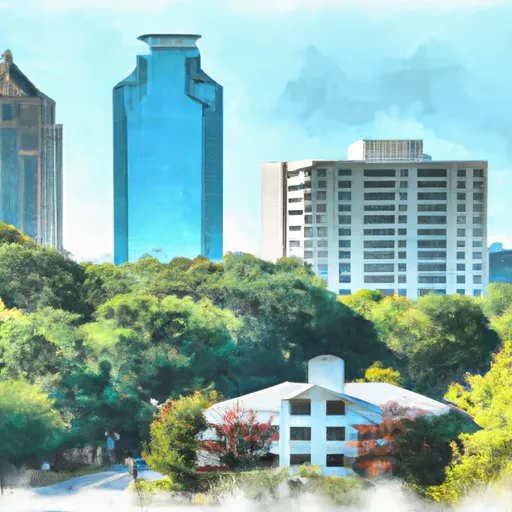-
 Snoflo Premium
Snoflo Premium
Get unlimited access to all our content
With no Ad interruptions! - Start Your Free Trial Login with existing account
Sandy-Springs
Eden Index
Climate
7.9
•
Recreation
6.3
•
Community
7.1
•
Safeguard
7.1/10

Sandy Springs, Georgia is a vibrant city located just north of Atlanta. The region experiences a humid subtropical climate, characterized by hot summers and mild winters. Summers are typically hot and humid, with temperatures averaging in the high 80s to low 90s Fahrenheit. Winters are generally mild, with temperatures ranging from the mid-40s to mid-50s Fahrenheit.
Hydrology constituents in Sandy Springs primarily revolve around the Chattahoochee River, which flows through the city. The river provides opportunities for various water activities, including kayaking, fishing, and boating. The city also boasts several parks and green spaces that offer hiking and biking trails, picnic areas, and playgrounds.
Outdoor recreation opportunities in Sandy Springs are diverse and plentiful. Chattahoochee River National Recreation Area is a popular spot for hiking, fishing, and wildlife observation. Morgan Falls Overlook Park provides access to the river and features walking trails, a playground, and picnic areas. The Abernathy Greenway Park offers a scenic trail for walking, running, or biking. Other recreational facilities include tennis courts, golf courses, and sports fields.
Overall, Sandy Springs offers a pleasant climate, a beautiful river, and numerous outdoor recreation opportunities for residents and visitors to enjoy.
What is the Eden Index?
The Snoflo Eden Index serves as a comprehensive rating system for regions, evaluating their desirability through a holistic assessment of climate health, outdoor recreation opportunities, and natural disaster risk, acknowledging the profound impact of these factors on livability and well-being.
Climate Health Indicator (CHI): 7.9
Sandy-Springs receives approximately
1308mm of rain per year,
with humidity levels near 86%
and air temperatures averaging around
16°C.
Sandy-Springs has a plant hardyness factor of
7, meaning
plants and agriculture in this region tend to thrive during the non-winter months.
By considering the ideal temperature range, reliable water supplies, clean air, and stable seasonal rain or snowpacks, the Climate Health Indicator (CHI) underscores the significance of a healthy climate as the foundation for quality living.
A healthy climate is paramount for ensuring a high quality of life and livability in a region, fostering both physical well-being and environmental harmony. This can be characterized by ideal temperatures, reliable access to water supplies, clean air, and consistent seasonal rain or snowpacks.
Weather Forecast
Streamflow Conditions
Apalachicola
Area Rivers
Apalachicola
Snowpack Depths
Apalachicola
Reservoir Storage Capacity
Apalachicola
Groundwater Levels
Recreational Opportunity Index (ROI): 6.3
The Recreational Opportunity Index (ROI) recognizes the value of outdoor recreational options, such as parks, hiking trails, camping sites, and fishing spots, while acknowledging that climate plays a pivotal role in ensuring the comfort and consistency of these experiences.
Access to outdoor recreational opportunities, encompassing activities such as parks, hiking, camping, and fishing, is crucial for overall well-being, and the climate plays a pivotal role in enabling and enhancing these experiences, ensuring that individuals can engage in nature-based activities comfortably and consistently.
Camping Areas
| Campground | Campsites | Reservations | Toilets | Showers | Elevation |
|---|---|---|---|---|---|
| Tumbling Creek | 8 | 1,505 ft | |||
| Parksville | 93 | 872 ft | |||
| Sweetwater - Allatoona Lake | None | 896 ft | |||
| Amicalola Falls State Park | None | 1,779 ft | |||
| Jacks River Fields | 14 | 2,865 ft | |||
| Quinn Springs Rec Area | 44 | 854 ft | |||
| Dobbins Lakeside Military | None | 1,079 ft | |||
| Big Lost Creek | 15 | 1,024 ft | |||
| Morganton Point | 82 | 1,753 ft | |||
| Thunder Rock | 42 | 1,140 ft |
Nearby Ski Areas
Catastrophe Safeguard Index (CSI):
The Catastrophe Safeguard Index (CSI) recognizes that natural disaster risk, encompassing floods, fires, hurricanes, and tornadoes, can drastically affect safety and the overall appeal of an area.
The level of natural disaster risk in a region significantly affects safety and the overall livability, with climate change amplifying these risks by potentially increasing the frequency and intensity of events like floods, fires, hurricanes, and tornadoes, thereby posing substantial challenges to community resilience and well-being.
Community Resilience Indicator (CRI): 7.1
The Community Resilience Indicator (CRI) recognizes that education, healthcare, and socioeconomics are crucial to the well-being of a region. The CRI acknowledges the profound impact of these elements on residents' overall quality of life. By evaluating educational resources, healthcare accessibility, and economic inclusivity, the index captures the essential aspects that contribute to a thriving community, fostering resident satisfaction, equity, and social cohesion.

